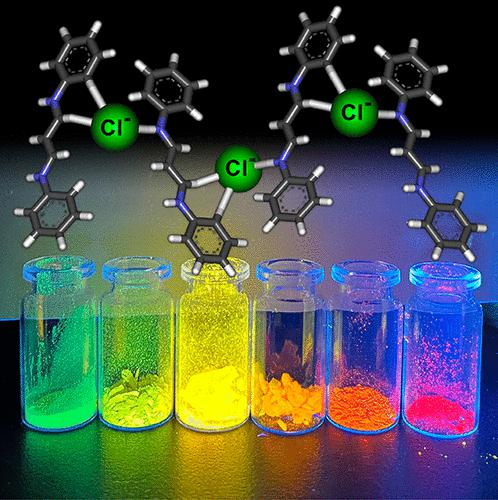当前位置:
X-MOL 学术
›
ACS Appl. Mater. Interfaces
›
论文详情
Our official English website, www.x-mol.net, welcomes your
feedback! (Note: you will need to create a separate account there.)
Halogen Bond-Driven Aggregation-Induced Emission Skeleton: N-(3-(Phenylamino)allylidene) Aniline Hydrochloride
ACS Applied Materials & Interfaces ( IF 8.3 ) Pub Date : 2023-02-10 , DOI: 10.1021/acsami.2c21073 Yongxin Chang 1, 2 , Haijuan Qin 3 , Fusheng Zhang 4 , Zhiying Yang 5 , Yahui Zhang 1 , Dongdong Wang 1 , Ce Bi 1, 4 , Miao Guo 1 , Wenjing Sun 1 , Guangyan Qing 1, 4
ACS Applied Materials & Interfaces ( IF 8.3 ) Pub Date : 2023-02-10 , DOI: 10.1021/acsami.2c21073 Yongxin Chang 1, 2 , Haijuan Qin 3 , Fusheng Zhang 4 , Zhiying Yang 5 , Yahui Zhang 1 , Dongdong Wang 1 , Ce Bi 1, 4 , Miao Guo 1 , Wenjing Sun 1 , Guangyan Qing 1, 4
Affiliation

|
Aggregation-induced emission (AIE) is a unique photophysical process, and its emergence brings a revolutionary change in luminescence. However, AIE-based research has been limited to a few classical molecular skeletons, which is unfavorable for in-depth studies of the photophysical characteristics of AIE and the full exploitation of their potential values. There is an urgent need to develop new skeletons to rise to the challenges of an insufficient number of AIE core structures and difficult modification. Here, we report a novel dumbbell AIE skeleton, in which two phenyls are connected through (E)-3-iminoprop-1-en-1-amine. This skeleton shows extremely strong solid-state emission with an absolute quantum yield up to 69.5%, a large Stokes shift, and typical AIE characteristics, which well resolves the challenge of difficult modification and low luminous efficiency of the traditional AIE skeletons. One-step reaction, high yield, and diversified modification endow the skeleton with great scalability from simple to complicated, or from symmetrical to asymmetrical structures, which establishes the applicability of the skeleton in various scenarios. These molecules self-assemble into highly ordered layer-, rod-, petal-, hollow pipe-, or helix-like nanostructures, which contribute to strong AIE emission. Crystallographic data reveal the highly ordered layer structures of the aggregates with different substituents, and a novel halogen bond-driven self-assembly mechanism that restricts intramolecular motion is clearly discovered. Taking advantage of these merits, a full-band emission system from green to red is successfully established, which displays great potential in the construction of light-emitting films and advanced light-emitting diodes. The discovery of this AIE skeleton may motivate a huge potential application value in luminescent materials and lead to hitherto impossible technological innovations.
中文翻译:

卤素键驱动的聚集诱导发射骨架:N-(3-(苯氨基)烯丙基)苯胺盐酸盐
聚集诱导发射(AIE)是一种独特的光物理过程,它的出现给发光带来了革命性的变化。然而,基于AIE的研究仅限于少数经典分子骨架,不利于深入研究AIE的光物理特性及其潜在价值的充分开发。迫切需要开发新的骨架来应对AIE核心结构数量不足和改造困难的挑战。在这里,我们报道了一种新型的哑铃AIE骨架,其中两个苯基通过( E )-3-iminoprop-1-en-1-amine连接。该骨架表现出极强的固态发射性能,绝对量子产率高达69.5%,斯托克斯位移大,具有典型的AIE特性,很好地解决了传统AIE骨架修饰困难、发光效率低的难题。一步反应、高产率、多样化修饰赋予骨架从简单到复杂、从对称到不对称结构的良好可扩展性,奠定了骨架在多种场景下的适用性。这些分子自组装成高度有序的层状、棒状、花瓣状、空心管状或螺旋状纳米结构,有助于产生强烈的 AIE 发射。晶体学数据揭示了具有不同取代基的聚集体的高度有序的层结构,并且清楚地发现了一种限制分子内运动的新颖的卤素键驱动的自组装机制。利用这些优点,成功建立了从绿光到红光的全波段发射系统,在发光薄膜和先进发光二极管的构建中显示出巨大的潜力。 这种AIE骨架的发现可能会激发发光材料巨大的潜在应用价值,并带来迄今为止不可能的技术创新。
更新日期:2023-02-10
中文翻译:

卤素键驱动的聚集诱导发射骨架:N-(3-(苯氨基)烯丙基)苯胺盐酸盐
聚集诱导发射(AIE)是一种独特的光物理过程,它的出现给发光带来了革命性的变化。然而,基于AIE的研究仅限于少数经典分子骨架,不利于深入研究AIE的光物理特性及其潜在价值的充分开发。迫切需要开发新的骨架来应对AIE核心结构数量不足和改造困难的挑战。在这里,我们报道了一种新型的哑铃AIE骨架,其中两个苯基通过( E )-3-iminoprop-1-en-1-amine连接。该骨架表现出极强的固态发射性能,绝对量子产率高达69.5%,斯托克斯位移大,具有典型的AIE特性,很好地解决了传统AIE骨架修饰困难、发光效率低的难题。一步反应、高产率、多样化修饰赋予骨架从简单到复杂、从对称到不对称结构的良好可扩展性,奠定了骨架在多种场景下的适用性。这些分子自组装成高度有序的层状、棒状、花瓣状、空心管状或螺旋状纳米结构,有助于产生强烈的 AIE 发射。晶体学数据揭示了具有不同取代基的聚集体的高度有序的层结构,并且清楚地发现了一种限制分子内运动的新颖的卤素键驱动的自组装机制。利用这些优点,成功建立了从绿光到红光的全波段发射系统,在发光薄膜和先进发光二极管的构建中显示出巨大的潜力。 这种AIE骨架的发现可能会激发发光材料巨大的潜在应用价值,并带来迄今为止不可能的技术创新。






























 京公网安备 11010802027423号
京公网安备 11010802027423号